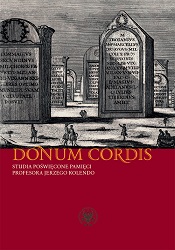The finds of the Przeworsk and Wielbark cultures in Herbert Jankuhn’s archives
The finds of the Przeworsk and Wielbark cultures in Herbert Jankuhn’s archives
Author(s): Adam Cieśliński
Subject(s): Archaeology
Published by: Wydawnictwa Uniwersytetu Warszawskiego
Keywords: Jerzy Kolendo; archaeology; Poland; Europe; University of Warsaw; Polish Academy of Sciences
Summary/Abstract: The well-known German archeologist Herbert Jankuhn at the beginning of his career dealt with archeology of the periodRoman on the south-eastern coast of the Baltic Sea. He created a huge one while working on his doctoratea file containing drawings and descriptions of monuments originating mainly from the area of East Prussia. She iscurrently kept at the Archäologisches Museum in Schleswig. They are in the archive above allinformation about artifacts from the Prussia-Museum in Königsberg that have been largely destroyed or scatteredduring the war. The largest part of the collection consists of notes about the Baltic lands during the period of influenceRoman, above all Sambia. An interesting collection is also dozens of flashcards presenting materialsPrzeworsk and Wielbark culture from areas located east of the lower Vistula. They present fullchronological spectrum of cultural units of interest to us in north-eastern Poland, beginning withfrom the beginning of the younger pre-Roman period in the case of Przeworsk culture, and ending with an early oneduring the migration period of the peoples, as regards the Wielbark culture. In this part of the archive you will find informationabout 25 archaeological sites, of which the German researcher documented 125 objects, mainly gravesand loose finds. The documentation covers a total of 276 monuments. The file also contains handwritten onesJankuhn drawings, showing 201 monuments, as well as 21 photos. Despite some imperfections, sketches andthe lack of more detailed descriptions of the monuments and the circumstances of their discovery Jankuhn flashcards are suitable for studytypological and chronological, so that these materials can be included in the settlement analysis andresearch on cultural divisions in the region. Information from the Jankuhn archives has also been successfullyused to identify monument-free monuments from Prussia-Sammlung in the Museum fürVor- und Frühgeschichte in Berlin.
Book: Donum cordis. Studia poświęcone pamięci Profesora Jerzego Kolendo
- Page Range: 67-74
- Page Count: 7
- Publication Year: 2019
- Language: English, Polish, German
- Content File-PDF

